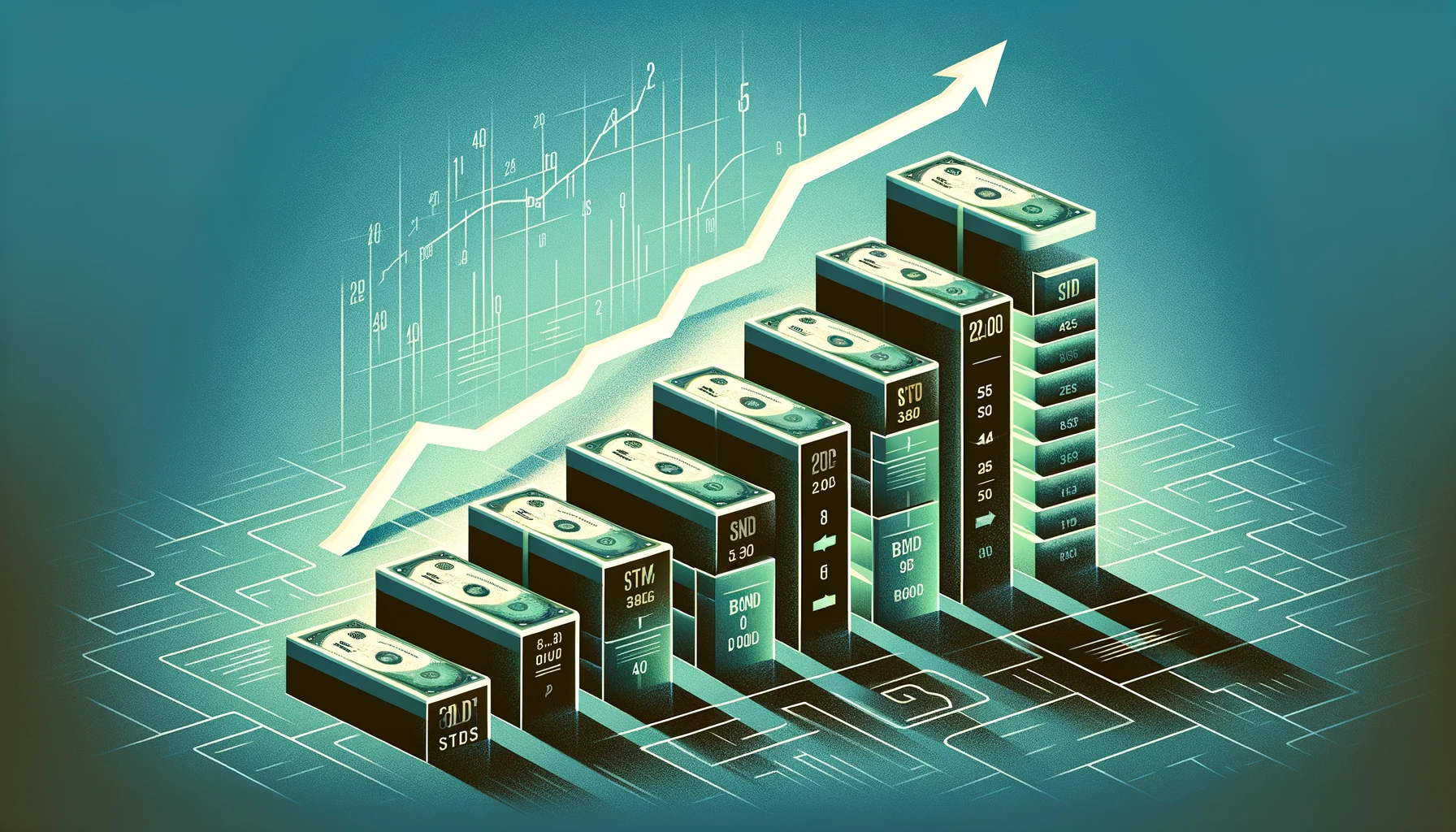As the economy experiences downturns, bond investments in Business Development Companies (BDCs) often offer better stability and reduced volatility compared to common shares. BDCs are at the mercy of market fluctuations, and their equity investments, particularly common shares, might see considerable price drops during recessions. On the contrary, bonds typically provide more predictable fixed income benefits, acting as a buffer against the unstable stock market. BDC bonds’ resilience during a recession can be attributed to their fixed-rate nature and having priority over equity in asset distribution, making them a potentially safer investment for capital preservation and ensuring a continuous income stream.

Key Takeaways
- Bonds offer stable returns and reduced vulnerability compared to common shares during a recession.
- BDC bonds’ fixed-rate nature and prioritization in asset distribution make them more resilient to economic downturns.
- Bond investments can act as a cushion against stock market unpredictability during economic instability.
- Fixed income benefits from bonds offer consistent returns, unlike variable dividend payouts from BDC stocks.
- Bonds in a BDC portfolio can enhance risk management and income diversification during uncertain times.
Understanding Business Development Companies in Uncertain Times
Business Development Companies (BDCs) are specialized investment firms designed to provide financing and invest in small to mid-size developing and distressed companies. Despite offering high dividend yields and liquidity due to their structure and tax benefits, BDCs are notably vulnerable during uncertain times due to interest rate fluctuations, management dependency, and concentration in potentially volatile sectors. They carry risks associated with high credit and liquidity as they hold illiquid, non-investment-grade assets. Understanding the nuances of BDC investments is crucial, particularly their responsiveness to economic changes and their ability to offer transparency and access to private equity-like investments without the typical lockups or minimum commitments.
| Advantages of BDCs | Challenges in Uncertain Times |
|---|---|
| High Dividend Yields | Interest Rate Fluctuations |
| Liquidity | Management Dependency |
| Tax Benefits | Concentration in Volatile Sectors |
| Access to Equity-like Investments | Risks Associated with High Credit and Liquidity |
Investing in BDCs can be advantageous, as they offer investors access to a variety of growing and distressed companies. Their structure allows them to distribute high dividends, even amidst a difficult economic landscape. However, it is essential for investors to carefully consider the risks that can be exacerbated by uncertain times. These risks include management dependency, as BDCs often rely on specialized managers to select and monitor investments, and concentration risks, as BDCs tend to focus on specific industries that can be volatile during economic downturns.
Understanding the responsiveness of BDCs to economic changes and the risks involved in investing can help investors make informed decisions, ultimately leading to the potential benefits of bond investments in BDCs.
Before investing in BDCs, it’s crucial to weigh the potential benefits against the challenges presented during uncertain times. The unique structure of BDCs provides access to private equity-like investments, which can translate to higher returns compared to traditional investments. However, understanding the risks that come with these investments, particularly in a fluctuating economic landscape, is essential for making well-informed investment decisions.
- High dividend yields can be attractive but subject to fluctuating market conditions
- Liquidity can provide easy access to investments and returns, but may also lead to increased risk in an unstable market
- Access to specialized management and investments in growing or distressed companies can lead to potential high returns, but it’s essential to understand the associated risks during economic downturns
In conclusion, understanding the unique advantages and risks associated with BDCs and their bond investments is essential for investors navigating uncertain times. By conducting thorough research and carefully analyzing individual companies and investment opportunities, investors can better position themselves for success in the fluctuating BDC landscape.
The Resilience of Bond Investments Compared to BDC Stocks

While Business Development Companies (BDCs) offer the potential for high returns through their equity investments, they are also subject to market fluctuations and economic downturns. In contrast, bond investments within BDCs, such as senior secured debt and subordinated debt, provide a level of risk management and stability that is not typically afforded by common shares.
Risk Management with Bond Investments
Senior secured debt is a type of bond investment that is prioritized and backed by collateral, offering greater security in the event of a liquidation. Subordinated debt, while still carrying some risk, is generally considered less risky than common equity shares, which are the last in line for asset distribution during liquidation. This structure of prioritizing debt holders over equity investors during repayments can make bond investments less risky and more resilient in the face of economic downturns.
| Type of Debt | Risks | Resilience |
|---|---|---|
| Senior Secured Debt | Lower risk due to prioritization and collateral | High resilience during economic downturns and liquidation |
| Subordinated Debt | Moderate risk (lower than equity shares) | Higher resilience than common equity shares |
| Common Equity Shares | Highest risk due to last position in asset distribution | Low resilience in market turbulence |
The diversification benefits of bonds also contribute to a well-balanced investment portfolio, reducing overall risk and enhancing stability.
Fixed Income Benefits During Market Turbulence
When the market experiences turbulence, fixed income investments like bonds offer consistent returns, unlike dividend payouts from BDC stocks, which can be highly variable and dependent on company performance. The preferential tax treatment and high-yield payments of BDCs are attractive, but they come with higher risks and potential for volatility. In contrast, bond investments provide a stable income source for investors during periods of uncertainty, mitigating the need to sell assets at potentially low prices.
Bond investments, distinguished by their fixed interest payments, offer a form of income generation and financial diversification that complements equity investments.
By investing in bonds within BDCs, investors can capitalize on the security and stability that fixed income assets offer and better manage risk during times of market turbulence.
Assessing the Dividend Yields of BDC Bonds Versus Shares
Business Development Companies (BDCs) are known for their high dividend yields due to their requirement to distribute 90% of income to shareholders for favorable tax treatment. However, these dividends can be volatile and affected by market conditions or company performance. In contrast, BDC bonds can provide a more predictable yield through regular interest payments. Let’s compare the dividend yields of BDC stocks and bonds to help investors determine the best strategy for their portfolios.
In times of economic uncertainty, BDC bonds may offer a steady income source with lower risk than the potentially higher, yet less predictable, dividends of BDC shares.
| BDC Investment | Dividend Yield | Risk Level |
|---|---|---|
| BDC Shares | Potentially High | Higher Risk |
| BDC Bonds | Steady Income | Lower Risk |
As shown in the table above, BDC shares can provide potentially high dividend yields, but they carry greater risk due to their dependence on market conditions and company profitability. BDC bonds, on the other hand, offer consistent returns through regular interest payments, making them more attractive for investors seeking a stable cash flow.
- Bond Market Benefits: BDC bonds deliver a steady income source during economic downturns, as they are less prone to market fluctuations and less reliant on company performance.
- BDC Dividend Yields: Despite their allure, BDC shares carry a higher risk compared to bonds, with the potential for volatile payouts and fluctuating dividend yields.
- High-Yield Dividends: When considering BDC investments, it’s crucial to weigh the potential high-yield dividends of shares against the relative stability of bonds to make informed decisions.
In conclusion, while BDCs are known for their high dividend yields, those who prioritize a stable cash flow and lower risk might find the bond market benefits more appealing. By comparing the yields and risks associated with BDC shares and bonds, investors can make strategic decisions that align with their financial goals and risk tolerance.
How Fixed-Rate BDC Bonds Offer Stability as Interest Rates Fluctuate
Fixed-rate BDC bonds provide stability in an investment portfolio, especially in environments where interest rates are volatile. These bonds lock in an interest rate, ensuring that investors benefit from a steady flow of income despite changing economic conditions. BDCs employ a mixture of fixed and floating-rate loans; however, in a fluctuating rate market, fixed-rate bonds can be particularly valuable as a hedge against the risk of widening interest rate spreads that can negatively impact the earning margins of BDCs operating with variable-rate loans. Having fixed-rate bonds in a portfolio can thus contribute to a reliable source of income generation and protect investor returns from the instability of the broader market.

The table below illustrates how fixed-rate BDC bonds may offer solid returns in an unpredictable interest rate environment, in comparison to floating-rate loans:
| Bond Type | Pros | Cons |
|---|---|---|
| Fixed-Rate BDC Bonds | Stable returns from bonds, predictable cash flows, less sensitive to interest rate changes | Potentially lower returns when interest rates rise, locked-in interest rates may be superseded |
| Floating-Rate Loans | Higher returns when interest rates rise, interest rate adjustments can potentially improve earnings | More volatile, unpredictable cash flows, more vulnerable to interest rate changes |
Income Generation from Bonds in a Volatile Rate Environment
As highlighted above, fixed-rate BDC bonds stand out for their ability to secure stable returns from bonds amidst the volatility in interest rates. Investors covet this predictability, as it offers a dependable income stream even during economically uncertain times. In contrast, floating-rate loans may offer higher returns when interest rates rise but are inherently more exposure to fluctuations and inconsistent cash flows.
“Fixed-rate BDC bonds provide a welcome sense of predictability in an investor’s portfolio, particularly in turbulent rate environments.”
To summarize, fixed-rate BDC bonds play a crucial role in offering stability as interest rates fluctuate. By incorporating them into an investment portfolio, investors have a higher likelihood of realizing a consistent and reliable source of income, even amidst uncertainty in the broader market.
Conclusion
Investing in BDC bonds can present unique opportunities for long-term growth and diversification benefits in one’s investment portfolio. The resilience and risk management offered by bonds are especially valuable during economic downturns, a level of stability that common shares often lack. In light of such challenging times, the fixed income generation from bond investments serves as a much-needed safeguard against market volatility, ensuring a steady flow of income and maintaining investor confidence.
To fully appreciate the advantages of BDC bonds over shares, it’s essential to assess their relative risks and rewards. Understanding the diversification benefits of bonds in contrast to the potential vulnerability of BDC shares during recessions can guide investors towards a more balanced and resilient portfolio. Access to reliable and predictable income sources is critical to navigating uncertain market conditions and achieving long-term financial goals.
In conclusion, we believe that investing in BDC bonds is a wise decision when considering both stability and growth potential. With a well-structured investment portfolio that includes a combination of bonds and shares, investors can minimize risks and capitalize on market opportunities to achieve their financial objectives. Recognizing the long-term benefits of bonds and dissecting market trends can empower investors to make informed decisions and realize their financial aspirations.
FAQ
What are the benefits of bond investments for BDCs during a recession?
Bond investments, especially fixed-rate bonds, provide several benefits for BDCs during a recession. These benefits include stable returns, risk management, a predictable income stream, and protection against market volatility.
How can investors understand the nuances of BDC investments in uncertain times?
Investors can better comprehend BDC investments in uncertain times by analyzing their responsiveness to economic changes, their ability to offer transparency and accessibility to private equity-like investments, and their associated risks, such as high credit and liquidity risks.
How do bond investments within BDCs offer better risk management compared to common shares?
Bond investments within BDCs, such as senior secured and subordinated debt, are prioritized and often backed by collateral, ensuring a higher level of risk management compared to common shares, which are the last in line for asset distribution during liquidation.
What are the advantages of fixed income benefits during market turbulence?
Fixed income benefits offer a consistent and predictable income source for investors during periods of uncertainty, mitigating the need to sell assets at potentially low prices, and providing financial diversification that complements equity investments.
How do the dividend yields of BDC bonds compare to BDC shares?
BDC bonds generally offer a more predictable yield through regular interest payments, whereas the dividend yields of BDC shares can be attractive but are subject to market conditions and company profitability, thus carrying higher risks and potential volatility.
How do fixed-rate BDC bonds provide stability in a fluctuating interest rate environment?
Fixed-rate BDC bonds lock in an interest rate, ensuring a steady flow of income despite changing economic conditions. This offers a reliable source of income generation and protects investor returns from the instability of the broader market, especially in fluctuating rate environments.
Source Links
- https://www.schwab.com/stocks/understand-stocks/bdcs
- https://www.kiplinger.com/investing/stocks/dividend-stocks/604419/best-bdcs
- https://solvefixedincome.com/bdc-common-stocks-market-recap-week-ended-june-3-2022/

Dr. Lincoln C. Wood teaches at the University of Otago in New Zealand. He is an avid investor and educator. He loves cash flow, income, and dividends when investing. He likes to buy undervalued companies with strong advantages and earnings growth.






